Oxaprozin
Editor-In-Chief: C. Michael Gibson, M.S., M.D. [1]; Associate Editor(s)-in-Chief: Alberto Plate [2]
Disclaimer
WikiDoc MAKES NO GUARANTEE OF VALIDITY. WikiDoc is not a professional health care provider, nor is it a suitable replacement for a licensed healthcare provider. WikiDoc is intended to be an educational tool, not a tool for any form of healthcare delivery. The educational content on WikiDoc drug pages is based upon the FDA package insert, National Library of Medicine content and practice guidelines / consensus statements. WikiDoc does not promote the administration of any medication or device that is not consistent with its labeling. Please read our full disclaimer here.
Black Box Warning
|
Boxed Warning
See full prescribing information for complete Boxed Warning.
Cardiovascular Risk:
Gastrointestinal Risk:
|
Overview
Oxaprozin is an analgesic and NSAID that is FDA approved for the treatment of osteoarthritis, rheumathoid arthritis and juvenile rheumatoid arthritis. There is a Black Box Warning for this drug as shown here. Common adverse reactions include abdominal pain, constipation, diarrhea, flatulence, indigestion, loss of appetite and nausea.
Adult Indications and Dosage
FDA-Labeled Indications and Dosage (Adult)
Carefully consider the potential benefits and risks of oxaprozin tablet, USP and other treatment options before deciding to use oxaprozin tablet, USP. Use the lowest effective dose for the shortest duration consistent with individual patient treatment goals. After observing the response to initial therapy with oxaprozin tablet, USP, the dose and frequency should be adjusted to suit an individual patient's needs.
Dosage
- Rheumatoid arthritis: For relief of the signs and symptoms of rheumatoid arthritis, the usual recommended dose is 1200 mg (two 600-mg tablets) given orally once a day.
- Osteoarthritis: For relief of the signs and symptoms of osteoarthritis, the usual recommended dose is 1200 mg (two 600-mg tablets) given orally once a day.
- Juvenile rheumatoid arthritis: For the relief of the signs and symptoms of JRA in patients 6-16 years of age, the recommended dose given orally once per day should be based on body weight of the patient as given in Table 3.
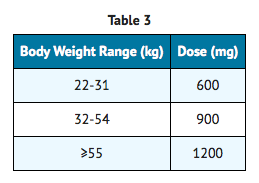
Off-Label Use and Dosage (Adult)
Guideline-Supported Use
There is limited information regarding Off-Label Guideline-Supported Use of Oxaprozin in adult patients.
Non–Guideline-Supported Use
There is limited information regarding Off-Label Non–Guideline-Supported Use of Oxaprozin in adult patients.
Pediatric Indications and Dosage
FDA-Labeled Indications and Dosage (Pediatric)
There is limited information regarding Oxaprozin FDA-Labeled Indications and Dosage (Pediatric) in the drug label.
Off-Label Use and Dosage (Pediatric)
Guideline-Supported Use
There is limited information regarding Off-Label Guideline-Supported Use of Oxaprozin in pediatric patients.
Non–Guideline-Supported Use
There is limited information regarding Off-Label Non–Guideline-Supported Use of Oxaprozin in pediatric patients.
Contraindications
Oxaprozin tablet, USP is contraindicated in:
- Patients with known hyper-sensitivity to oxaprozin.
- Patients who have experienced asthma, urticaria, or allergic-type reactions after taking aspirin or other NSAIDs. Severe, rarely fatal, anaphylactic-like reactions to NSAIDs have been reported in such patients.
- Peri-operative pain in the setting of coronary artery bypass graft (CABG) surgery.
- Patients with active gastrointestinal bleeding.
Warnings
|
Boxed Warning
See full prescribing information for complete Boxed Warning.
Cardiovascular Risk:
Gastrointestinal Risk:
|
Cardiovascular Effects
Cardiovascular Thrombotic Events
- Clinical trials of several COX-2 selective and nonselective NSAIDs of up to three years duration have shown an increased risk of serious cardiovascular (CV) thrombotic events, myocardial infarction, and stroke, which can be fatal. All NSAIDs, both COX-2 selective and nonselective, may have a similar risk. Patients with known CV disease or risk factors for CV disease may be at greater risk. To minimize the potential risk for an adverse CV event in patients treated with an NSAID, the lowest effective dose should be used for the shortest duration possible. Physicians and patients should remain alert for the development of such events, even in the absence of previous CV symptoms. Patients should be informed about the signs and/or symptoms of serious CV events and the steps to take if they occur.
- There is no consistent evidence that concurrent use of aspirin mitigates the increased risk of serious CV thrombotic events associated with NSAID use. The concurrent use of aspirin and an NSAID does increase the risk of serious GI events.
- Two large, controlled clinical trials of a COX-2 selective NSAID for the treatment of pain in the first 10-14 days following CABG surgery found an increased incidence of myocardial infarction and stroke.
Hypertension
- NSAIDs including oxaprozin, can lead to onset of new hypertension or worsening of pre-existing hypertension, either of which may contribute to the increased incidence of CV events. Patients taking thiazides or loop diuretics may have impaired response to these therapies when taking NSAIDs. NSAIDs, including oxaprozin, should be used with caution in patients with hypertension. Blood pressure (BP) should be monitored closely during the initiation of NSAID treatment and throughout the course of therapy.
Congestive Heart Failure and Edema
- Fluid retention and edema have been observed in some patients taking NSAIDs. oxaprozin should be used with caution in patients with fluid retention or heart failure.
Gastrointestinal Effects- Risk of Ulceration, Bleeding, and Perforation
- NSAIDs, including oxaprozin, can cause serious gastrointestinal (GI) adverse events including inflammation, bleeding, ulceration, and perforation of the stomach, small intestine, or large intestine, which can be fatal. These serious adverse events can occur at any time, with or without warning symptoms, in patients treated with NSAIDs. Only one in five patients, who develop a serious upper GI adverse event on NSAID therapy, is symptomatic. Upper GI ulcers, gross bleeding, or perforation caused by NSAIDs occur in approximately 1% of patients treated for 3-6 months, and in about 2-4% of patients treated for one year. These trends continue with longer duration of use, increasing the likelihood of developing a serious GI event at some time during the course of therapy. However, even short-term therapy is not without risk.
- NSAIDs should be prescribed with extreme caution in those with a prior history of ulcer disease or gastrointestinal bleeding. Patients with a prior history of peptic ulcer disease and/or gastrointestinal bleeding who use NSAIDs have a greater than 10-fold increased risk for developing a GI bleed compared to patients treated with neither of these risk factors. Other factors that increase the risk of GI bleeding in patients treated with NSAIDs include concomitant use of oral corticosteroids or anticoagulants, longer duration of NSAID therapy, smoking, use of alcohol, older age, and poor general health status. Most spontaneous reports of fatal GI events are in elderly or debilitated patients and therefore, special care should be taken in treating this population.
- To minimize the potential risk for an adverse GI event in patients treated with an NSAID, the lowest effective dose should be used for the shortest possible duration. Patients and physicians should remain alert for signs and symptoms of GI ulcerations and bleeding during NSAID therapy and promptly initiate additional evaluation and treatment if a serious GI event is suspected. This should include discontinuation of the NSAID until a serious GI adverse event is ruled out. For high risk patients, alternate therapies that do not involve NSAIDs should be considered.
- Oxaprozin tablet, USP is contraindicated in patients with active GI bleeding.
Renal Effects
- Long-term administration of NSAIDs has resulted in renal papillary necrosis and other renal injury. Renal toxicity has also been seen in patients in whom renal prostaglandins have a compensatory role in the maintenance of renal perfusion. In these patients, administration of a nonsteroidal anti-inflammatory drug may cause a dose dependent reduction in prostaglandin formation and, secondarily, in renal blood flow, which may precipitate overt renal decompensation. Patients at greatest risk of this reaction are those with impaired renal function, heart failure, liver dysfunction, those taking diuretics and ACE inhibitors, and the elderly. Discontinuation of NSAID therapy is usually followed by recovery to the pretreatment state.
Advanced renal disease
- No information is available from controlled clinical studies regarding the use of oxaprozin in patients with advanced renal disease. Therefore, treatment with oxaprozin is not recommended in these patients with advanced renal disease. If oxaprozin therapy must be initiated, close monitoring of the patient's renal function is advisable.
Anaphylactoid reactions
- As with other NSAIDs, anaphylactoid reactions may occur in patients without known prior exposure to oxaprozin. Oxaprozin should not be given to patients with the aspirin triad. This symptom complex typically occurs in asthmatic patients who experience rhinitis with or without nasal polyps, or who exhibit severe, potentially fatal bronchospasm after taking aspirin or other NSAIDs. Emergency help should be sought in cases where an anaphylactoid reaction occurs.
Skin Reactions
- NSAIDs, including oxaprozin, can cause serious skin adverse events such as exfoliative dermatitis, Stevens-Johnson Syndrome (SJS), and toxic epidermal necrolysis (TEN), which can be fatal. These serious events may occur without warning. Patients should be informed about the signs and symptoms of serious skin manifestations and use of drug should be discontinued at the first appearance of skin rash or any other sign of hypersensitivity.
Pregnancy
- In late pregnancy, as with other NSAIDs, oxaprozin should be avoided because it may cause premature closure of the ductus arteriosus.
Adverse Reactions
Clinical Trials Experience
Adverse reaction data were derived from patients who received oxaprozin in multidose, controlled, and open-label clinical trials, and from worldwide marketing experience. Rates for events occurring in more than 1% of patients, and for most of the less common events, are based on 2253 patients who took 1200 to 1800 mg oxaprozin per day in clinical trials. Of these, 1721 were treated for at least 1 month, 971 for at least 3 months, and 366 for more than 1 year. Rates for the rarer events and for events reported from worldwide marketing experience are difficult to estimate accurately and are only listed as less than 1%.
Incidence Greater Than 1%: In clinical trials of oxaprozin or in patients taking other NSAIDs, the following adverse reactions occurred at an incidence greater than 1%.
- Cardiovascular system: edema.
- Digestive system: abdominal pain/distress, anorexia, constipation, diarrhea, dyspepsia, flatulence, gastrointestinal ulcers (gastric/duodenal), gross bleeding/perforation, heartburn, liver enzyme elevations, nausea, vomiting.
- Hematologic system: anemia, increased bleeding time.
- Nervous system: CNS inhibition (depression, sedation, somnolence, or confusion), disturbance of sleep, dizziness, headache.
- Skin and appendages: pruritus, rash.
- Special senses: tinnitus.
- Urogenital system: abnormal renal function, dysuria or frequency.
Incidence Less Than 1%: The following adverse reactions were reported in clinical trials, from worldwide marketing experience (in italics) or in patients taking other NSAIDs.
- Body as a whole: appetite changes, death, drug hypersensitivity reactions including anaphylaxis, fever, infection, sepsis, serum sickness.
- Cardiovascular system: arrhythmia, blood pressure changes, congestive heart failure, hypertension, hypotension, myocardial infarction, palpitations, tachycardia, syncope, vasculitis.
- Digestive system: alteration in taste, dry mouth, eructation, esophagitis, gastritis, glossitis, hematemesis, jaundice, liver function abnormalities including hepatitis, liver failure, stomatitis, hemorrhoidal or rectal bleeding, pancreatitis.
- Hematologic system: agranulocytosis, aplastic anemia, ecchymoses, eosinophilia, hemolytic anemia, lymphadenopathy, melena, pancytopenia, purpura, thrombocytopenia, leukopenia.
- Metabolic system: hyperglycemia, weight changes.
- Nervous system: anxiety, asthenia, coma, convulsions, dream abnormalities, drowsiness, hallucinations, insomnia, malaise, meningitis, nervousness, paresthesia, tremors, vertigo, weakness.
- Respiratory system: asthma, dyspnea, pulmonary infections, pneumonia, sinusitis, symptoms of upper respiratory tract infection, respiratory depression.
- Skin: alopecia, angioedema, urticaria, photosensitivity, pseudoporphyria, exfoliative dermatitis, erythema multiforme, Stevens-Johnson syndrome, sweat, toxic epidermal necrolysis (Lyell's syndrome).
- Special senses: blurred vision, conjunctivitis, hearing decrease.
- Urogenital: acute interstitial nephritis, cystitis, hematuria, increase in menstrual flow, nephrotic syndrome, oliguria/polyuria, proteinuria, renal insufficiency, acute renal failure, decreased menstrual flow.
Postmarketing Experience
There is limited information regarding Oxaprozin Postmarketing Experience in the drug label.
Drug Interactions
There is limited information regarding Oxaprozin Drug Interactions in the drug label.
Use in Specific Populations
Pregnancy
- Teratology studies with oxaprozin were performed in mice, rats, and rabbits. In mice and rats, no drug-related developmental abnormalities were observed at 50 to 200 mg/kg/day of oxaprozin (225 to 900 mg/m2). However, in rabbits, infrequent malformed fetuses were observed in dams treated with 7.5 to 30 mg/kg/day of oxaprozin (the usual human dosage range). Animal reproductive studies are not always predictive of human response. There are no adequate or well-controlled studies in pregnant women. Oxaprozin should be used during pregnancy only if the potential benefits justify the potential risks to the fetus.
Pregnancy Category (AUS):
There is no Australian Drug Evaluation Committee (ADEC) guidance on usage of Oxaprozin in women who are pregnant.
Labor and Delivery
- In rat studies with NSAIDs, as with other drugs known to inhibit prostaglandin synthesis, an increased incidence of dystocia, delayed parturition, and decreased pup survival occurred. The effects of DAYPRO on labor and delivery in pregnant women are unknown.
Nursing Mothers
- It is not known whether this drug is excreted in human milk; however, oxaprozin was found in the milk of lactating rats. Because many drugs are excreted in human milk and because of the potential for serious adverse reactions in nursing infants from DAYPRO, a decision should be made whether to discontinue nursing or to discontinue the drug, taking into account the importance of the drug to the mother.
Pediatric Use
- A population pharmacokinetic study indicated no clinically important age dependent changes in the apparent clearance of unbound oxaprozin between adult rheumatoid arthritis patients (N=40) and juvenile rheumatoid arthritis (JRA) patients (≥6 years, N=44) when adjustments were made for differences in body weight between these patient groups. The extent of protein binding of oxaprozin at various therapeutic total plasma concentrations was also similar between the adult and pediatric patient groups. Pharmacokinetic model-based estimates of daily exposure (AUC0-24) to unbound oxaprozin in JRA patients relative to adult rheumatoid arthritis patients suggest dose to body weight range relationships as shown in Table 2. No pharmacokinetic data are available for pediatric patients under 6 years of age
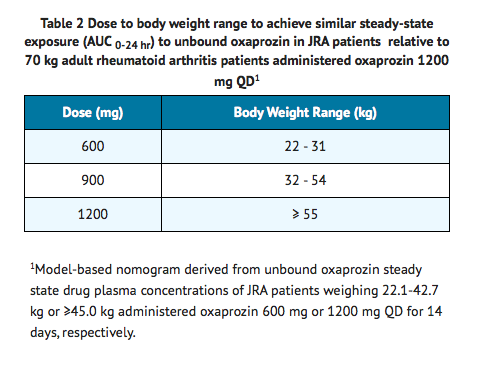
Geriatic Use
- As with any NSAID, caution should be exercised in treating the elderly (65 years and older). No dosage adjustment is necessary in the elderly for pharmacokinetics reasons, although many elderly may need a reduced dose due to low body weight or disorders associated with aging.
- A multiple dose study comparing the pharmacokinetics of oxaprozin (1200 mg QD) in 20 young (21 -44 years) adults and 20 elderly (64-83 years) adults, did not show any statistically significant differences between age groups.
Gender
There is no FDA guidance on the use of Oxaprozin with respect to specific gender populations.
Race
- Pharmacokinetics differences due to race have not been identified.
Renal Impairment
- The pharmacokinetics of oxaprozin have been investigated in patients with renal insufficiency. Oxaprozin's renal clearance decreased proportionally with creatinine clearance (CrCl), but since only about 5% of oxaprozin dose is excreted unchanged in the urine, the decrease in total body clearance becomes clinically important only in those subjects with highly decreased CrCl. Oxaprozin is not significantly removed from the blood in patients undergoing hemodialysis or continuous ambulatory peritoneal dialysis (CAPD) due to its high protein binding. Oxaprozin plasma protein binding may decrease in patients with severe renal deficiency. Dosage adjustment may be necessary in patients with renal insufficiency
Hepatic Impairment
There is no FDA guidance on the use of Oxaprozin in patients with hepatic impairment.
Females of Reproductive Potential and Males
There is no FDA guidance on the use of Oxaprozin in women of reproductive potentials and males.
Immunocompromised Patients
There is no FDA guidance one the use of Oxaprozin in patients who are immunocompromised.
Cardiac Failure
- Well-compensated cardiac failure does not affect the plasma protein binding or the pharmacokinetics of oxaprozin.
Administration and Monitoring
Administration
There is limited information regarding Oxaprozin Administration in the drug label.
Monitoring
There is limited information regarding Oxaprozin Monitoring in the drug label.
IV Compatibility
There is limited information regarding the compatibility of Oxaprozin and IV administrations.
Overdosage
- No patient experienced either an accidental or intentional overdosage of oxaprozin in the clinical trials of the drug. Symptoms following acute overdose with other NSAIDs are usually limited to lethargy, drowsiness, nausea, vomiting, and epigastric pain and are generally reversible with supportive care. Gastrointestinal bleeding and coma have occurred following NSAID overdose. Hypertension, acute renal failure, and respiratory depression are rare. Anaphylactoid reactions have been reported with therapeutic ingestion of NSAIDs, and may occur following an overdose.
- Patients should be managed by symptomatic and supportive care following an NSAID overdose. There are no specific antidotes. Gut decontamination may be indicated in patients seen within 4 hours of ingestion with symptoms or following a large overdose (5 to 10 times the usual dose). This should be accomplished via emesis and/or activated charcoal (60 to 100 g in adults, 1 to 2 g/kg in children) with an osmotic cathartic. Forced diuresis, alkalization of the urine, or hemoperfusion would probably not be useful due to the high degree of protein binding of oxaprozin.
Pharmacology

| |
Oxaprozin
| |
| Systematic (IUPAC) name | |
| 3-(4,5-diphenyl-1,3-oxazol-2-yl)propanoic acid | |
| Identifiers | |
| CAS number | |
| ATC code | M01 |
| PubChem | |
| DrugBank | |
| Chemical data | |
| Formula | Template:OrganicBox atomTemplate:OrganicBox atomTemplate:OrganicBoxTemplate:OrganicBoxTemplate:OrganicBoxTemplate:OrganicBoxTemplate:OrganicBoxTemplate:OrganicBoxTemplate:OrganicBoxTemplate:OrganicBoxTemplate:OrganicBoxTemplate:OrganicBoxTemplate:OrganicBoxTemplate:OrganicBox atomTemplate:OrganicBoxTemplate:OrganicBox atomTemplate:OrganicBoxTemplate:OrganicBoxTemplate:OrganicBoxTemplate:OrganicBoxTemplate:OrganicBoxTemplate:OrganicBoxTemplate:OrganicBox |
| Mol. mass | 293.317 g/mol |
| SMILES | & |
| Pharmacokinetic data | |
| Bioavailability | 95% |
| Protein binding | 99% |
| Metabolism | Liver—65% oxidation and 35% glucuronic acid conjugation. 5% are active phenolic metabolites. |
| Half life | 54.9 hours |
| Excretion | ? |
| Therapeutic considerations | |
| Pregnancy cat. |
C |
| Legal status |
Prescription Only (S4)(AU) rx only |
| Routes | Oral |
Mechanism of Action
- The mechanism of action of oxaprozin like that of other NSAIDs, is not completely understood but may be related to prostaglandin synthetase inhibition.
Structure

Pharmacodynamics
- Oxaprozin is a nonsteroidal anti-inflammatory drug (NSAID) that exhibits anti-inflammatory, analgesic, and antipyretic properties in animal models.
Pharmacokinetics
Absorption
- Oxaprozin is 95% absorbed after oral administration. Food may reduce the rate of absorption of oxaprozin, but the extent of absorption is unchanged. Antacids do not significantly affect the extent and rate of oxaprozin absorption.
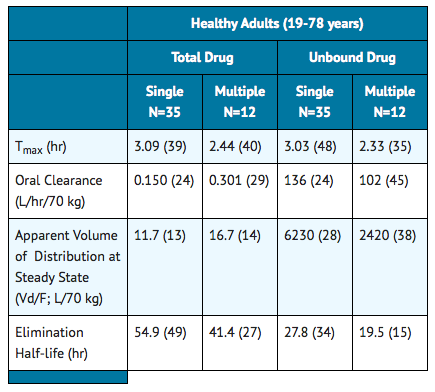
Distribution
- In dose proportionality studies utilizing 600, 1200 and 1800 mg doses, the pharmacokinetics of oxaprozin in healthy subjects demonstrated nonlinear kinetics of both the total and unbound drug in opposite directions, i.e., dose exposure related increase in the clearance of total drug and decrease in the clearance of the unbound drug. Decreased clearance of the unbound drug was related predominantly to a decrease in the volume of distribution and not an increase in the half-life. This phenomenon is considered to have minimal impact on drug accumulation upon multiple dosing.
- The apparent volume of distribution (Vd/F) of total oxaprozin is approximately 11-17 L/70 kg. Oxaprozin is 99% bound to plasma proteins, primarily to albumin. At therapeutic drug concentrations, the plasma protein binding of oxaprozin is saturable, resulting in a higher proportion of the free drug as the total drug concentration is increased. With increases in single doses or following repetitive once-daily dosing, the apparent volume of distribution and clearance of total drug increased, while that of unbound drug decreased due to the effects of nonlinear protein binding. Oxaprozin penetrates into synovial tissues of rheumatoid arthritis patients with oxaprozin concentrations 2-fold and 3-fold greater than in plasma and synovial fluid, respectively. Oxaprozin is expected to be excreted in human milk based on its physical-chemical properties, however, the amount of oxaprozin excreted in breast milk has not been evaluated.
Metabolism
- Several oxaprozin metabolites have been identified in human urine or feces.
- Oxaprozin is primarily metabolized by the liver, by both microsomal oxidation (65%) and glucuronic acid conjugation (35%). Ester and ether glucuronide are the major conjugated metabolites of oxaprozin. On chronic dosing, metabolites do not accumulate in the plasma of patients with normal renal function. Concentrations of the metabolites in plasma are very low.
- Oxaprozin's metabolites do not have significant pharmacologic activity. The major ester and ether glucuronide conjugated metabolites have been evaluated along with oxaprozin in receptor binding studies and in vivo animal models and have demonstrated no activity. A small amount (<5%) of active phenolic metabolites are produced, but the contribution to overall activity is limited.
Excretion
- Approximately 5% of the oxaprozin dose is excreted unchanged in the urine. Sixty-five percent (65%) of the dose is excreted in the urine and 35% in the feces as metabolite. Biliary excretion of unchanged oxaprozin is a minor pathway, and enterohepatic recycling of oxaprozin is insignificant. Upon chronic dosing the accumulation half-life is approximately 22 hours. The elimination half-life is approximately twice the accumulation half-life due to increased binding and decreased clearance at lower concentrations.
Nonclinical Toxicology
There is limited information regarding Oxaprozin Nonclinical Toxicology in the drug label.
Clinical Studies
Rheumatoid Arthritis
- Oxaprozin was evaluated for managing the signs and symptoms of rheumatoid arthritis in placebo and active controlled clinical trials in a total of 646 patients. Oxaprozin was given in single or divided daily doses of 600 to 1800 mg/day and was found to be comparable to 2600 to 3900 mg/day of aspirin. At these doses there was a trend (over all trials) for oxaprozin to be more effective and cause fewer gastrointestinal side effects than aspirin.
- Oxaprozin was given as a once-a-day dose of 1200 mg in most of the clinical trials, but larger doses (up to 26 mg/kg or 1800 mg/day) were used in selected patients. In some patients, oxaprozin may be better tolerated in divided doses. Due to its long half-life, several days of oxaprozin therapy were needed for the drug to reach its full effect.
Osteoarthritis
- Oxaprozin was evaluated for the management of the signs and symptoms of osteoarthritis in a total of 616 patients in active controlled clinical trials against aspirin (N=464), piroxicam (N=102), and other NSAIDs. Oxaprozin was given both in variable (600 to 1200 mg/day) and in fixed (1200 mg/day) dosing schedules in either single or divided doses. In these trials, oxaprozin was found to be comparable to 2600 to 3200 mg/day doses of aspirin or 20 mg/day doses of piroxicam. Oxaprozin was effective both in once-daily and in divided dosing schedules. In controlled clinical trials several days of oxaprozin therapy were needed for the drug to reach its full effects.
How Supplied
- Oxaprozin tablets, USP, 600 mg are available as: white to off-white, capsule shaped film coated tablets with “391” debossed on one side and scored on the other side in the bottles of 100 (NDC 57664-391-08), 500 (NDC 57664-391-13) and 1000 (NDC 57664-391-18).
Storage
- Store at controlled room temperature 15°-30°C (59°-86°F). Dispense in tight, light-resistant container as defined in the USP, with child resistant closure.
Images
Drug Images
{{#ask: Page Name::Oxaprozin |?Pill Name |?Drug Name |?Pill Ingred |?Pill Imprint |?Pill Dosage |?Pill Color |?Pill Shape |?Pill Size (mm) |?Pill Scoring |?NDC |?Drug Author |format=template |template=DrugPageImages |mainlabel=- |sort=Pill Name }}
Package and Label Display Panel
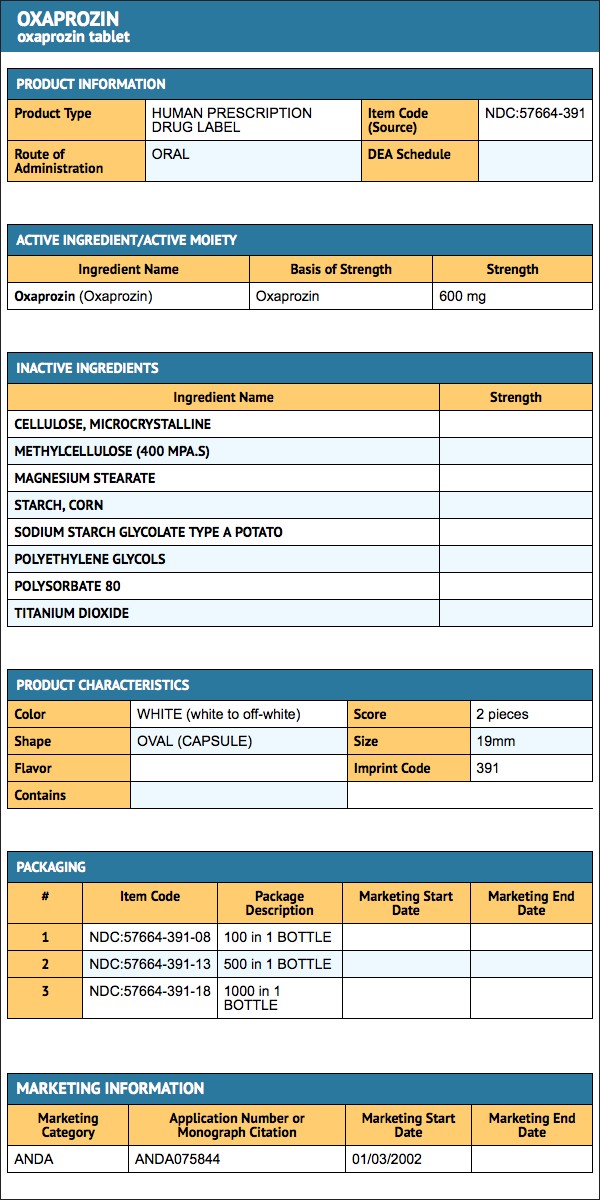
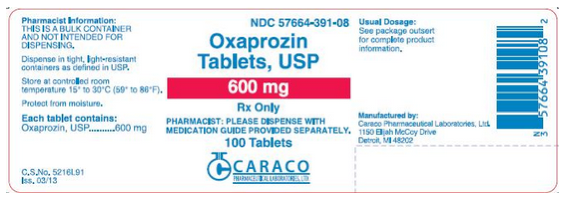
{{#ask: Label Page::Oxaprozin |?Label Name |format=template |template=DrugLabelImages |mainlabel=- |sort=Label Page }}
Patient Counseling Information
There is limited information regarding Oxaprozin Patient Counseling Information in the drug label.
Precautions with Alcohol
- Alcohol-Oxaprozin interaction has not been established. Talk to your doctor about the effects of taking alcohol with this medication.
Brand Names
Look-Alike Drug Names
There is limited information regarding Oxaprozin Look-Alike Drug Names in the drug label.
Drug Shortage Status
Price
References
The contents of this FDA label are provided by the National Library of Medicine.